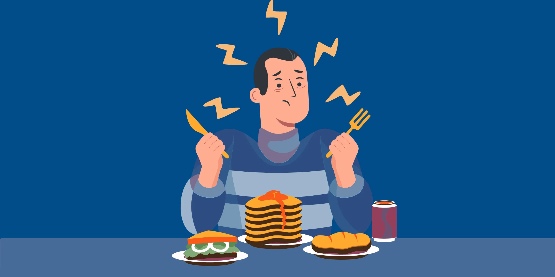
You may have heard of Eating Disorders, including Anorexia Nervosa and Bulimia Nervosa, but most people have never heard of Binge Eating Disorder. This is a newer psychological diagnosis that has some similarities to Bulimia, but also some distinct differences. It is important to note that Binge Eating Disorder is one of the eating disorders in men that often goes unnoticed. Learn more about the symptoms of Binge Eating Disorder, its associated characteristics, health risks, and when to seek help:
Diagnostic Criteria for Binge Eating Disorder
If you haven't heard of Binge Eating Disorder, you are not alone. Many people are not familiar with this condition. This is because this diagnosis was first formalized in May 2013 with the publication of the Diagnostic and Statistical Manual Fifth Edition (DSM-5). This is the guidebook that psychologists, counselors, and doctors use to determine whether someone has a mental health problem.
With this guideline, psychologists use the following criteria for Binge Eating Disorder symptoms:
-Recurrent and persistent binge eating attacks
Binge eating episodes include three or more of the following behaviors:
-Eating much faster than normal
-Eating until you feel uncomfortably full
-Eating large amounts of food while not feeling physically hungry
-Eating alone because he is ashamed of how much he eats
-Feeling self-disgust, depressed, or very guilty after overeating
-Marked distress with binge eating
Typical Signs and Symptoms of Binge Eating Disorder
The primary characteristic of Binge Eating Disorder is the behavior of eating large amounts of food in a short period of time, even if you do not feel physically hungry. Often, when people with Binge Eating Disorder begin to overeat, they may feel completely out of control with their behavior. They may feel compelled to continue eating even after becoming uncomfortably full. Binge Eating Disorder, along with Anorexia and Bulimia, is generally classified as an Eating Disorder. All three involve some disordered eating behavior and often a disorder in the person's body. However, all three have different symptoms. Bingeing characterizes binge eating disorder, which contrasts with Anorexia Nervosa, where people restrict their eating. Many people confuse Binge Eating Disorder with Bulimia Nervosa. However, people with Bulimia Nervosa engage in compensatory behaviors such as vomiting to eliminate food, and those with Binge Eating Disorder do not.
Characteristics Associated with Binge Eating Disorder
Most people dealing with Binge Eating Disorder are in their late teens or early 20s. It has been reported in younger children and older adults, but less frequently. People tend to associate Eating Disorders with women. However, men can also struggle with these problems. In fact, almost 40% of people diagnosed with Binge Eating Disorder are men. Men and women of all ages can be affected by binge eating disorder. Approximately 3.5% of women in the United States have this disorder, while 2% of men have it. During adolescence, Binge Eating Disorder tends to affect more women than men. Starting in middle age, more men struggle with these behaviors. No matter how old you are when these symptoms begin, it's important to reach out for help.People with binge eating symptoms may also be affected by symptoms of Anxiety and Depression. If an individual has issues with their weight or even obesity, the likelihood of this increases and mental health symptoms tend to be even more severe. Many people with anxiety develop disordered eating behaviors as a way to cope. The opposite may also be true, because a person with Binge Eating Disorder may later develop anxiety in part because they have the disorder.
Warning Signs of Binge Eating Disorder
If you're worried about someone else in your life who you suspect may have Binge Eating Disorder, you may notice some warning signs. People with Binge Eating Disorder may try to hide some of their behaviors, so it can be difficult to tell for sure what they are struggling with. If they are hiding their food, that alone is a big sign. Evidence that someone is hiding food may appear in the form of empty food containers and garbage collected in unusual places such as bedrooms and cars. They may be secretive or even evasive when answering questions about their eating habits.If someone exhibits unusual eating behaviors, this does not necessarily mean they have Binge Eating Disorder. However, when you are concerned about someone in your life, it is better to talk to them and discuss the behaviors you notice. It often helps to approach the person at a time when the two of you can have a calm, quiet conversation away from other people. Sometimes just explaining what you've noticed and letting them know you're ready to talk can help them feel more comfortable and get them to open up to you. Then, you can figure out the next steps together. After the psychological treatment process of binge eating disorder is completed, a suitable program should be prepared with a nutritionist to establish a nutritional routine and acquire normal eating habits. In this process, if the cause of binge eating disorder is a different psychological disorder, the therapist determines which therapy method is required for the treatment of this disease and that therapy method is applied.
